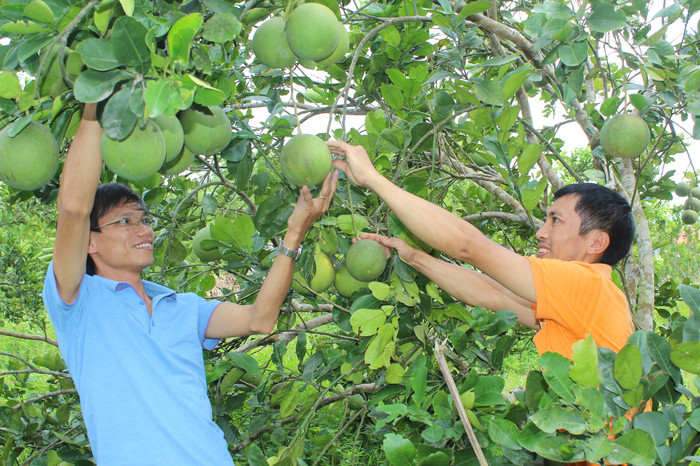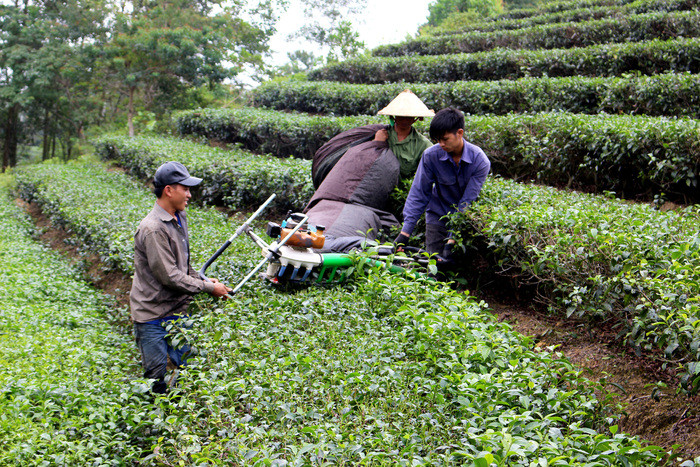Dien grapefruit becomes the main crop in Thanh Chuong
(Baonghean) -In the conditions of small-scale, fragmented production and attracting local industrial investment is still "standing still". Faced with that reality, along with promoting commercial livestock farming, Thanh Chuong district (Nghe An) promotes the development of high-value potential key crops. In which, bDien Bien is included in the list with policies to encourage development.
Promoting the strengths of traditional trees
Identified as one of the key tea growing areas of Nghe An province, Thanh Chuong district currently has over 4,000 hectares of tea (about 55% of the province's total area). Tea trees are considered a traditional crop, because they have been rooted for decades and although their value is not high, they bring stable income to growers.
In recent years, farmers have increased investment in intensive farming, applied scientific and technical advances, and used microbial fertilizers, so tea productivity has continuously increased (about 13 tons/ha/year). With 3,650 hectares being exploited, each year the output of tea buds is over 43,800 tons, with product value reaching about 150 billion VND, accounting for 4.15% of the total product value of the agricultural sector.
 |
| Dien grapefruit garden of Mr. Ho Sy Phuong's family (right) in hamlet 5, Thanh Lien commune (Thanh Chuong) - Photo: Nguyen Son |
According to Mr. Nguyen Xuan Anh - Deputy Head of the Department of Agriculture and Rural Development of Thanh Chuong district, tea trees in the district have gradually affirmed their socio-economic efficiency, contributing to increasing people's income, becoming one of the main crops in the area.
One hectare of tea yields a net profit of around 25 million VND per year. The development of tea trees is linked with 5 companies and enterprises, 50 factories and private processing facilities in the communes. In recent years, tea processing factories have promptly purchased fresh tea buds for farmers.
However, most of the production line equipment is outdated, tea products are mainly raw, low quality, not highly competitive; production costs are high, product value is low, reinvestment of factories and sustainable links with tea growers are not strong.
At the same time, tea trees in the area face some limitations such as: low productivity, pests and diseases still occur, low quality products, and low income from tea trees. However, tea is still a sustainable crop, the district will focus on directing investment in intensive cultivation, improving productivity and linking to increase product value.
In Thanh Chuong district, cassava is also maintained with a raw material area of over 2,800 hectares. This is also a plant that has been present in the district for decades and is determined to be suitable for many areas of barren hilly land, contributing to hunger eradication, poverty reduction, creating more jobs, and bringing economic efficiency to producers.
Especially in recent years, Intimex Cassava Starch Factory, with a processing capacity of 600 tons of fresh tubers/day, has organized timely fresh cassava purchasing through 60 product purchasing points for farmers according to each locality and production area of the farmers, so there is no need to worry about the output of cassava tubers.
However, cassava has fluctuated in area and productivity in recent times. Because it is easy to grow, people have not followed the correct technical process, most of the cassava area is not planted at the right density, planted too densely, and has not paid attention to intensive farming, so cassava productivity is unstable and tends to decrease.
According to calculations, one hectare of cassava yields a net profit of 21-23 million VND per year. That income level is not attractive to the people, but most of the hilly land in the district, "looking back and forth", is still most suitable for cassava and has stability when associated with a processing factory.
At the same time, the rice growing areas in Thanh Chuong district mainly serve the goal of food security. As for raw material forests, households' calculations only earn about 6-7 million VND/ha/year, so the development of "multi-purpose" forestry trees, which have both environmental value, increase coverage, and economic value, such as: Melaleuca, Black Melaleuca, Jackfruit.
Faced with that reality, Thanh Chuong is struggling to find ways to develop new crops with high economic value, suitable for the terrain and climate.
» Taking care of key trees and animals in Thanh Chuong
 |
| Thanh Chuong farmers harvest tea. - Photo: Dinh Ha |
Hope for the new tree
When discussing key trees to increase value and income for people, Mr. Le Dinh Thanh - Vice Chairman of Thanh Chuong District People's Committee is very fond of orange trees and Dien grapefruit trees.
According to Mr. Thanh, many people think it is a "new tree", but in fact, over the years, Dien orange and grapefruit trees have taken root and generated income in many areas such as: Youth volunteer teams; communes: Thanh Lien, Thanh Nho, Thanh Duc, Thanh Thuy, Thanh Tien...
Through surveys, oranges and grapefruits planted in the above areas in the 9th and 10th year have high productivity (oranges 120 quintals/ha; grapefruit 104 quintals/ha). These two crops, according to calculations, bring in income from 340 - 370 million/ha/year. Therefore, Thanh Chuong district carefully studied the area, included in the planning until 2020 to plant about 500 hectares of oranges (currently over 330 hectares), 110 hectares of Dien grapefruit (currently 24 hectares) and have policies to encourage development.
According to Decision 2817/QD-UBND (July 2016) of Thanh Chuong District People's Committee, households growing oranges (V2 orange variety, Xa Doai) will be supported with 10,000 VND/tree for households growing oranges in the planning area (Thanh Hoa, Thanh Nho, Thanh Duc, Hanh Lam, Thanh Thuy communes) with a minimum concentrated planting area of 1,000 m2 or more. Households growing Dien grapefruit will be supported by the district with 20,000 VND/seedling and land preparation costs of 5,000,000 VND/ha for households growing Dien grapefruit in the planning area (Thanh Lien, Thanh Tien, Thanh Ngoc, Thanh Phong communes) with a minimum concentrated planting area of 1,000m2 or more. |
Mr. Ho Sy Phuong's family in Hamlet 5, Thanh Lien Commune was a pioneer in growing Dien grapefruit when the district had no support policy. Since 2008, he has boldly planted 1 hectare of Dien grapefruit (500 trees) and now has planted nearly 3 hectares.
With the district's support policy, Mr. Phuong continues to reinvest and currently, his family's planned area for growing Dien grapefruit is about 5 hectares. His family has the advantage of being able to rent 5% of the commune's land fund, thus creating a large commercial Dien grapefruit growing area.
In 2016, Dien grapefruit in Thanh Chuong area was sold for 25,000 - 30,000 VND/fruit, bringing a large income to Mr. Phuong's family. In particular, this type of grapefruit can be stored for 2-3 months after harvest, so there is no fear of slow consumption. With the support of the district and some models in the area, farmers in Thanh Lien, Thanh Ngoc, Thanh Phong communes are currently promoting land consolidation to grow Dien grapefruit.
Implementing the project on developing some key crops, in the first 6 months of 2017, Thanh Chuong district planted over 5.2 hectares of V2 oranges; 10.6 hectares of Xa Doai oranges; 7.71 hectares of Dien grapefruit; and 1,100 hectares of concentrated forests.
Through discussion, Mr. Le Dinh Thanh added: Crops such as oranges and Dien grapefruit in Thanh Chuong district are still mainly grown on small-scale, household scale and many people have not invested in intensive farming, have not strictly applied technical measures in care, so productivity is low.
Meanwhile, Dien orange and grapefruit trees are "difficult" trees, requiring strict requirements on soil conditions as well as cultivation techniques. Therefore, the district advocates carefully studying suitable land and climate when implementing the planning, and at the same time implementing technical measures well to bring high economic efficiency. On that basis, with the proposed planning, the district strengthens planning management, and actively connects and finds stable output for the products.
Nguyen Son
| RELATED NEWS |
|---|
